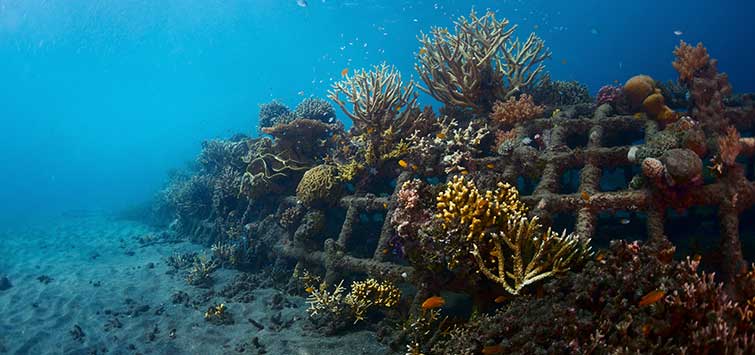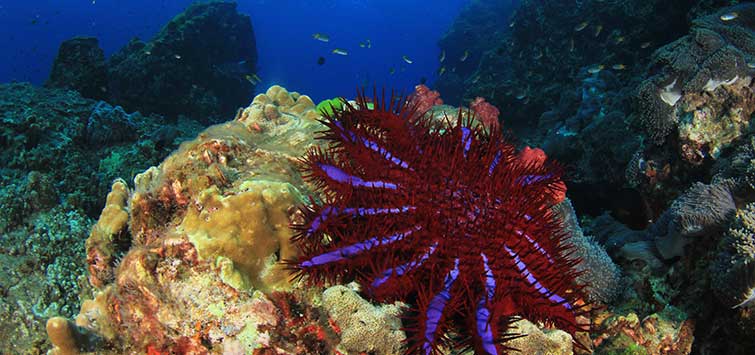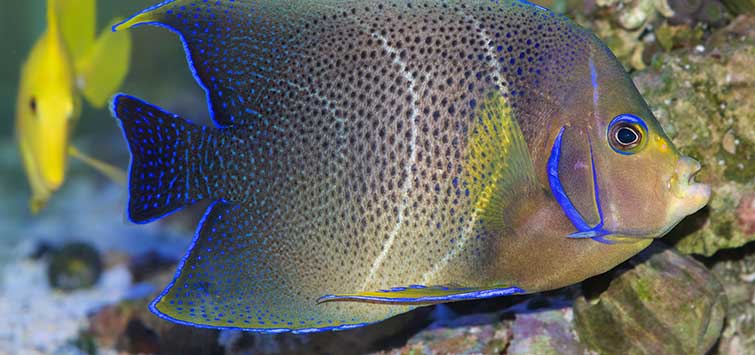Coral Reef Restoration in Pemuteran: the Biorock Project
Author: Francesco Ricciardi
Coral reefs are in danger all over the world thanks to environmental and human factors. An eco-tourist and accomplished scuba diver discusses attempts to reverse this trend via the Biorock® project in Pemuteran, Indonesia.
Threats to Coral Reefs
Coral reefs face myriad threats worldwide, oftentimes from human activity. In some parts of the world, the local community and scientists are fighting to recover the damaged reefs and restore their ancient splendor.
One of the biggest issues in tropical countries is the deterioration of coastal coral reefs due to many factors, such as coastal erosion, illegal dynamite and cyanide fishing, chemical pollution, and other threats. Over the past 20 years, these combined factors have destroyed many coral reefs and coral areas around tropical countries worldwide.
Reef Functions
Healthy coral reefs are vital to the survival of not only aquatic creatures, but coastal populations as well. They provide food, serve as nurseries for many species of commercially important fish, and can be a huge source of income via the tourism industry. For people living in coastal villages in developing countries, scuba diving, snorkeling, and other water sports can be far more valuable than fishing.
Dynamite Fishing
Unfortunately, even if prohibited by law, dynamite fishing is still practiced in many parts of the Western Indo-Pacific archipelago, and a large part of the coral reefs around the Philippines, Indonesia, and Malaysia have been destroyed, especially in remote areas where patrolling and sea surveillance are very difficult.
Underwater bombs are normally prepared using a bottle and some chemicals like powdered potassium and pebbles or ammonium nitrate (a common fertilizer) mixed with kerosene. Once released in the water (but sometimes even before, causing serious injuries to the fishermen) the bomb explodes. These explosions rupture the swim bladders of surrounding fish, which are easily collected later.
Due to the nature of the explosion, this fishing method affects more than just the target animals and irreversibly damages the fragile coral reef ecosystem. Wonderful coral gardens that were teeming with life are reduced to deserted areas of coral rubble. Even worse, they become unsafe regions for fish to mate, and they create adverse conditions for new coral larvae settlement, meaning these areas will be unable to recover for a very long time, if at all.
Saving the Reef
In areas popular with scuba divers, local villagers or conservation organizations have tried to develop coral restoration projects using various techniques to encourage coral growth. Some create a coral nursery while setting up coral structures that can act as refuges for fish and substrates for coral colonization. While these projects are important to the future of reef restoration, it takes a long time for them to have an impact, since it takes corals years to grow.
Electric Mineral Accretion
Some years ago, two scientists (Professor Wolf H. Hilbertz, who passed away in 2007, and Dr. Thomas Goreau, who is at the moment President of the Coral Reef Alliance) discovered a technology called electrical mineral accretion (which is known as Biorock®). Basically, a low-voltage current in seawater causes dissolved minerals to crystallize and form structures similar to limestone, on which coral larvae can settle and grow. Moreover, it seems that this low voltage can stimulate carbonate deposition by corals, increasing their growth rate.
A new Biorock® structure starts with the positioning of a submerged anode (negative pole), normally an electrically conductive frame made from wire mesh. The anode is connected to a low-voltage electrical current that is not harmful to fish or other sea life. A metallic submerged structure acts as the cathode (positive pole), starting an electrolytic chemical reaction that causes the precipitation of minerals naturally present in seawater, such as calcium carbonate and magnesium hydroxide, which are deposited on the structure’s surface. After only a few days, a whitish layer of minerals already covers the structure.
When the first layer of limestone has been deposited, some so-called baby corals (living fragments of broken corals coming from other areas) are implanted on the structure, where the current stimulates their growth. It has been calculated that they can increase their growth rate to almost five times that of a normal coral. The limestone deposit also helps the reef recover from other environmental stresses, such as fractures, high temperatures, waves, or excessive sedimentation.
This technology has been further developed and adapted for use in coastal environments, where it’s possible to use photovoltaic generators, or a device using waves or wind generators, to create a self-sustaining system using green energy to stimulate the coral recovery. One of the most awesome examples of this technology’s success is easily observable in few feet of water in front of the village of Pemuteran, North Bali.
The Pemuteran Biorock Project
The Biorock project in Pemuteran started in the year 2000, when the Karang Lestari Foundation was formed. The funds from Karang Lestari were combined with a small investment from local dive operators and hotels with the aim of rebuilding local coral reefs that had been heavily bombed in previous years. Since then, many workshops have been conducted by the scientists in Bali, and even in other areas of Indonesia, with the purpose of creating a network of Biorock projects. Up to six Biorock projects are currently operating in Indonesia, with Pemuteran and Gili Trawangan (Lombok) being the largest ones.
In Pemuteran, only a few years after the first structure was installed, the results are amazing to behold. The corals grow quickly and are healthy, and fish life is abundant. Invertebrates like crabs, sea slugs, and shrimp are abundant and now occupy every shelter inside the Biorock. Some local dive guides and instructors are working hard to get new funds from tourists and create new structures.
Since the base of the Biorock can be placed in whatever shape you choose, it can be an artistic way of regrowing corals. Sculptures such as metallic crabs, nudibranchs, a sea goddess, igloos, and even old bicycles have been sunk onto the reef and are now the basis of new coral reef formations.
The Biorock Pemuteran project in 2012 was awarded the Equator Prize by the United Nations Development Programme (UNDP) for being the world’s largest, longest-running, and best coral reef restoration project. The Karang Lestari Foundation expects to implement this technology in other areas in Bali, such as Lovina and Karangasem.
Komang Astika, diving instructor and native of Pemuteran, is one of the members who have been with the Karang Lestari Foundation since the beginning. “I started volunteering in 2000, when I was still very young, because I believe that all our community depends on the health of the coral reefs. Since 2007 I have become a full member of the Biorock Project,” he said.
Tourists diving and snorkeling in Pemuteran can contribute with their donations. The money is used to create new metallic structures, and donors will have their name molded in the metal. With a bigger donation, they can fund a whole metallic structure in the shape they like.
“During the high season, more than 50 tourists per day visit the Biorock, both through diving and snorkeling,” said Komang “and they can do more: with only 5 million rupiahs they can sponsor a whole structure, or with 350,000 rupiahs they can sponsor a baby coral that will be installed in one of the new structures.” Komang and the other members of the Biorock staff will make sure that the coral will grow and will send the donor a certificate, pictures of the coral, and pictures of the entire structure every following year.
The Karang Lestari Foundation
If you want more information about the Biorock Project, to donate, or to stay informed about their latest projects, visit their website, biorockbali.webs.com, or their office located exactly on the beach of Pemuteran, between the Pondok Sari Hotel and the Taman Sari Resort.
Diving or Snorkeling in the Pemuteran Biorock Area
Pemuteran is located in the northeast of Bali, in the Buleleng Regency. Surrounded by an amazing landscape, with the “Tiga Saudara” mountains on its back and the Java volcano’s alley in front, it’s one of the newer tourist destinations but still far away from the hustle of the south, since it takes approximately four hours to get there from Denpasar.
The Biorock project is located exactly in front of the Taman Sari hotel, and it’s freely accessible from the beach. Even if just snorkeling, it’s possible to appreciate the incredible coral life, although scuba diving is the best way to fully enjoy the experience. It’s a very easy dive, with a shore-entry and a maximum depth of about 15 meters (50 feet), and it’s open to divers of every experience level. Any dive center in the area can organize a dive in the Biorock. Just make sure they support the Karang Lestari Project in some way.
See the full article on TFH Digital http://www.tfhdigital.com/tfh/mar_2014#pg85

.png?h=595&iar=0&w=2781&hash=5FD5E69473BCC22199FBFA2FB71B6033)



